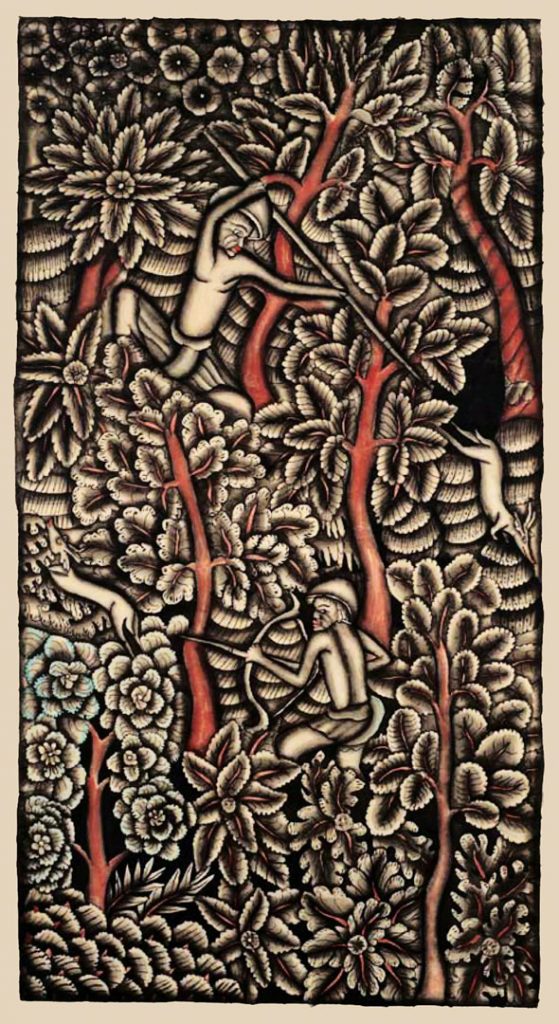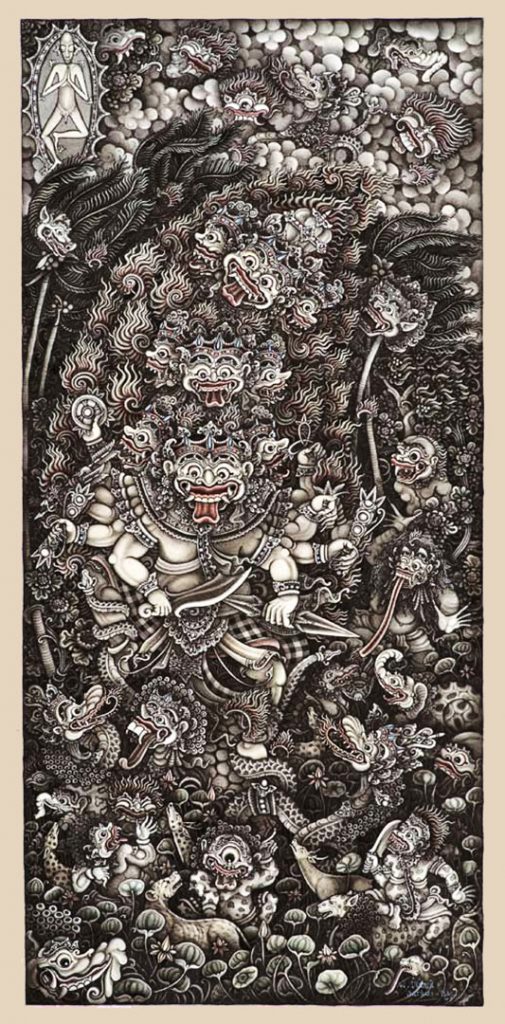Batuan paintings are remarkably dense with deeply saturated tones. Their images are often dark and sometimes macabre, but they are always carefully made and carefully balanced. The forms in the paintings swirl and intertwine, they repeat each other and expand outwards until they transform into new shapes and new patterns. They create labyrinths of pulsating light that leave very little room for either the mind or the eye to rest.

Dewa Kompiang Kandel Ruka
42-24 cm. paper
1930’s
These paintings are characterised by high levels of energy in both form and content. The subject matter is vivid, indeed many of the subjects portrayed seem to have been chosen for their sensational qualities. There are mythical creatures engaged in titanic struggles, there are murders by decapitation, demons attacking women during childbirth, kidnappings, heroic deeds. But even when the artists choose to portray the mundane details of everyday life, the scenes are infused with a kind of super ordinariness, even the routines of life end up looking extraordinary and shimmering with energy.
The sheer number of objects and situations depicted in Batuan paintings is staggering, almost encyclopaedic in its range. We might identify most easily with the people portrayed, the full cast of characters that could be found in any south Bali village. These people are shown in the contexts they have created for themselves, the built environments of the house compounds and the village temples. They are shown involved in their typical activities, their ritual life, their passions and obsessions. They are shown with the plants they cultivate, the animals they domesticate, and sometimes with the oceans
-where they fish.
The natural world, on the other hand, is shown as an entirely distinct environment with its own laws and qualities. These wild places seem unstable and incomprehensible, only the very brave or very reckless would spend much time there. The spirit world occupies a special place in the Balinese psyche, and there are many portrayals of its subtle complexities. There are countless types of spiritual beings depicted, they appear, disappear, change form and then appear again in another place. They exercise their powers at will and only allow themselves to be marginally affected by human concerns, changing their minds often to become an ally one day, and then an enemy the next.
And then there are Bali’s visitors, from the earliest travellers in the 1930s to the mass influx of tourists in the present day. The paintings show these visitors belonging to neither the known world of the village nor the unknown world of nature, they arrive from beyond any comprehensible world, like space aliens wandering around in the painting.

I Wayan Diana
65-30cm. Paper
2007
Aesthetically speaking, each painting is made up of countless individual shapes, carefully delineated and discrete, almost as if each shape could be lifted out of the painting like a single piece of a jigsaw puzzle. These individual forms relate to each other in two different ways, they are either repeated as similar shapes creating areas of rhythm, or they are used in opposition to each other creating contrasts and visual tension. Most Batuan paintings contain thousands of these forms either working together or in opposition to create complex fields of pulsating energy, this is what gives them their unique visual sparkle. This same love of multiplicity also gives Batuan paintings a tendency towards baroque over elaboration, the viewer can become tangled up in this mass of jostling forms and be left with only a memory of collected minutiae. But the best paintings don’t get lost in their details, the most successful works focus all of the individual elements towards to a single goal of pictorial unity. Seen from across the room, the hundreds or thousands of forms that make up a Batuan painting create one single unified image, shifting and swaying and held in an uneasy balance.
In spite of this robust bristling energy, these paintings are not the product of a hot-blooded expressiveness. The artists of Batuan do not lunge at their paper in a creative fury, painting for them is more like playing chess. Paintings are developed step by step in a very calculated manner and rendered meticulously, nothing is blurred, nothing is out of place, and nothing is left to chance. Painting in Batuan is nothing like a bull rampaging through a china shop, it is more a matter of rendering a wild raging bull in fine delicate porcelain. In fact one source of dynamism in these paintings lies precisely in the way such vigorous subjects and forms are so carefully rendered.
Serialised from the book
Inventing Art, The Paintings Of Batuan Bali
A book by Bruce Granquist






